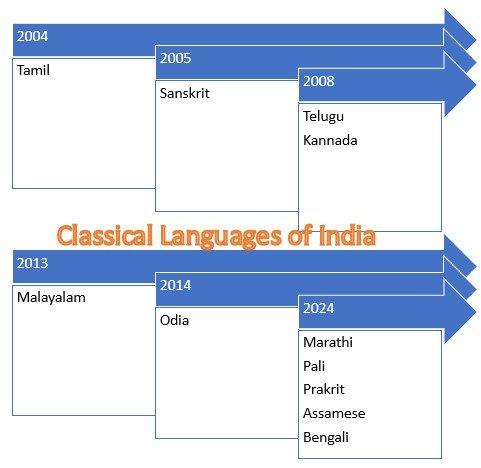Art & Culture, AWIP
Q. Identify the benefits of recognizing any language as a classical language. State the bases of it’s recognition.
The Classical Languages serve as a custodian of Bharat’s profound and ancient cultural heritage, embodying the essence of each community’s historical and cultural milestone. The Government of India decided to create a new category of languages as “Classical Languages” on 12th October 2004 declaring Tamil as the first Classical Language. And now, the Union Cabinet chaired by the Prime Minister Shri Narendra Modi has approved (on October 3, 2024) to confer the status of Classical Language to Marathi, Pali, Prakrit, Assamese and Bengali languages. Hence as of October 3, 2024, the 11 classical languages of India are:
-
- Tamil: The first language to be recognized as a classical language in 2004
- Sanskrit: Recognized in 2005
- Telugu: Recognized in 2008
- Kannada: Recognized in 2008
- Malayalam: Recognized in 2013
- Odia: Recognized in 2014
- Marathi: Recognized in 2024
- Pali: Recognized in 2024
- Prakrit: Recognized in 2024
- Assamese: Recognized in 2024
- Bengali: Recognized in 2024
Recognizing a language as a “classical language” provides it with specific benefits and acknowledges its historical and cultural significance. In India, certain languages have been given this status by the Ministry of Culture, emphasizing their ancient heritage and contribution to the country’s intellectual history. Here are the benefits and criteria for recognizing a language as classical:
Benefits of Recognizing a Language as Classical
- Funding and Grants: Institutions working on research, preservation, and promotion of the language receive government funding. This includes academic support for studies, translations, and publications.
- Research and Scholarship: Scholars and students can access scholarships and special grants to study and conduct research on classical languages. This facilitates academic contributions and keeps the language’s literary and historical records alive.
- Dedicated Research Centers: Universities may establish specific research centers for classical languages, furthering the study and development of the language and its literature.
- Preservation and Revitalization: Recognition boosts efforts to protect and preserve the language’s unique cultural aspects, including its scripts, literature, and art forms.
- Cultural Pride and Identity: The status affirms cultural pride, connecting people with their historical roots, and encouraging cultural identity through literary and linguistic appreciation.
Criteria for Recognition of a Classical Language
The criteria for recognizing a language as classical are set by the Ministry of Culture, Government of India, and include:
- Antiquity: The language must have an early recorded history of at least 1500-2000 years, with a body of ancient texts and literature.
- Distinctive Heritage: It must have a distinct literary tradition that is independent and not borrowed from another language or culture.
- Rich Literary History: The language should have a large volume of ancient and valuable literary texts that span various subjects and genres.
- Cultural Legacy: It must be considered a valuable part of the national cultural heritage, contributing significantly to India’s literary, philosophical, and cultural history.
- Discontinuity from Living Languages: Classical languages are often distinct from contemporary languages and have an independent history, separated from their modern descendants.
These criteria and benefits are essential to safeguarding linguistic diversity and maintaining the legacy of India’s rich linguistic and cultural heritage.


